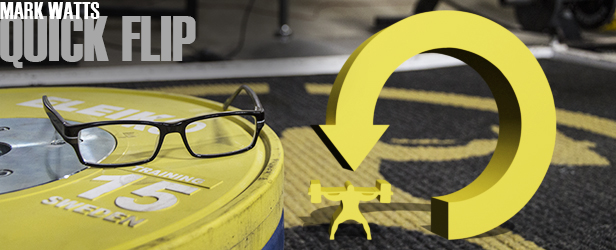
What is a Quick Flip?
- Taken directly from elitefts™ Training Logs or Q&As
- Opinionated
- Unedited
The old-school meat-head coach way of asking your question is "how do I keep my fat-ass lineman in shape without pounding their legs?"
I am teasing about the question. One thing have learned during my short time on the elitefts™ Q&A is that I better know my stuff. And anything I answer that is even slightly off-track or may not have any scientific backing, I will get called out on. That is definitely a good thing is hopefully that is why we will continue to be the go-to site when it comes to real-world, in the trenches, under the bar, (add more cliches here) sports performance training.
Before giving insight to your question, I will say this is an issue that many coaches are trying to deal with and figure out. There is no completely correct protocol because of individual variances, programming, resources, etc.
The three methods you listed are adequate and seem to elicit a positive training effect, but I understand your concern. Since you obviously have a good understanding of training, I will give a few examples of how to reduce the ground contact time with any variations of conditioning rather than explain the "why it's important." You are way past that, Josh.
Get in the Pool
I know you resources are limited, but this can be an excellent way to increase aerobic capacity without impact. This was our go-to conditioning session the day after games. You have to be concerned with the resistance of the water. These sessions can easily turn into fast glycolitic energy system sessions and can produce more lactic acid than desired. Especially is you are one of the "Aerobic-alactic" die-hards. On top of this you have all of the logistically issues that come up with scheduling, life guards, comfortably in the water, etc. Overall, treading, jogging, legs kicks, etc. can all be helpful for the big dudes.
Conditioning at Practice
As a strength coach, you may or may not have the final say in conditioning during or after practice. I am not going to have the debate about "Why Football players don't need to run 300 yard shuttles and Gassers." Your specific conditioning tests are up to you. But it's funny that I hear all the negative about L.A. type conditioning, but there are a lot of teams that run 110s, Gassers, and Shuttles. Another topic, another time. Regardless, if you are going to condition during practice, adjust distances and reps for the OL/DL positions. It seems coaches will easily adjust target times, but not total distance for the heavier athletes.
- You could adjust 110 distance (OL ran 80 yards, DL=90, Big Skill 100, Skill=110).
- If skill players are running 40s, OL could run 10s or 20s
- Skill = 60-yard shuttles, OL 20-yard Shuttles.
- Another example: if you were to run 300-yard shuttles (not advocating or condemning); there is a big different in 25 & back x 6 and 50 & back x 3 in terms of COD and energy systems.
Upper Body Conditioning
This may be painfully obvious, but you could incorporate upper body activities to raise the heart rate. With upper body movements, you won't be as concerned with lactic acid. Tabata circuits with Conditioning Ropes, Sledgehammer swings, etc. can increase aerobic capacity, eliminate impact, and even add hypertrophy.
Machines
Not as "Football Cool" but some of the cardio machines (if you can get the skinny-fat NARPs off of them) can be effective way to increase the aerobic capacity and there is not impact. But, just like the pool, these sessions can quickly get out of the oxidate energy system and reduce effectiveness and even defeat the entire purpose by adding soreness. Keeping the heart rate at the target you want them can be achieved on the elliptical bike, rower, etc. The application of the equipment is more important.
Final Thoughts
Josh, if your only choice is to run your big guys on the field, then you are dong the best job you can. Tempo Runs (see Charlie Francis or The Thinker), LSD runs, and Med Ball Circuits with active recovery (I Like Tim Beltz protocol with these) is the way to go. I hope some of these alternatives help and some will fit into your particular training style. Best of luck this off-season and keep motioning the performance, you will know when to gear down or ramp it up.
Mark Watts' Training Log
Articles by Mark Watts









Good to hear from you my man. I know, it's tough when another grown man holds us accountable for our actions as coaches and athletes. Definitely a better person because of all of my coaches even if I didn't think so at the time.
You should run a campaign to untie all NARPs across the country. You have already taken over all college rec. weight rooms, why not the world? ;)
You have the power to transform from a NARP to an ARP which solid training, decent nutrition, and no gym selfies.
I should have been more specific with the machine comment. We had a bike, treadmill, and even elliptical protocol for injured athletes. We just didn't use it much because of proximity and a pretty solid pool program.